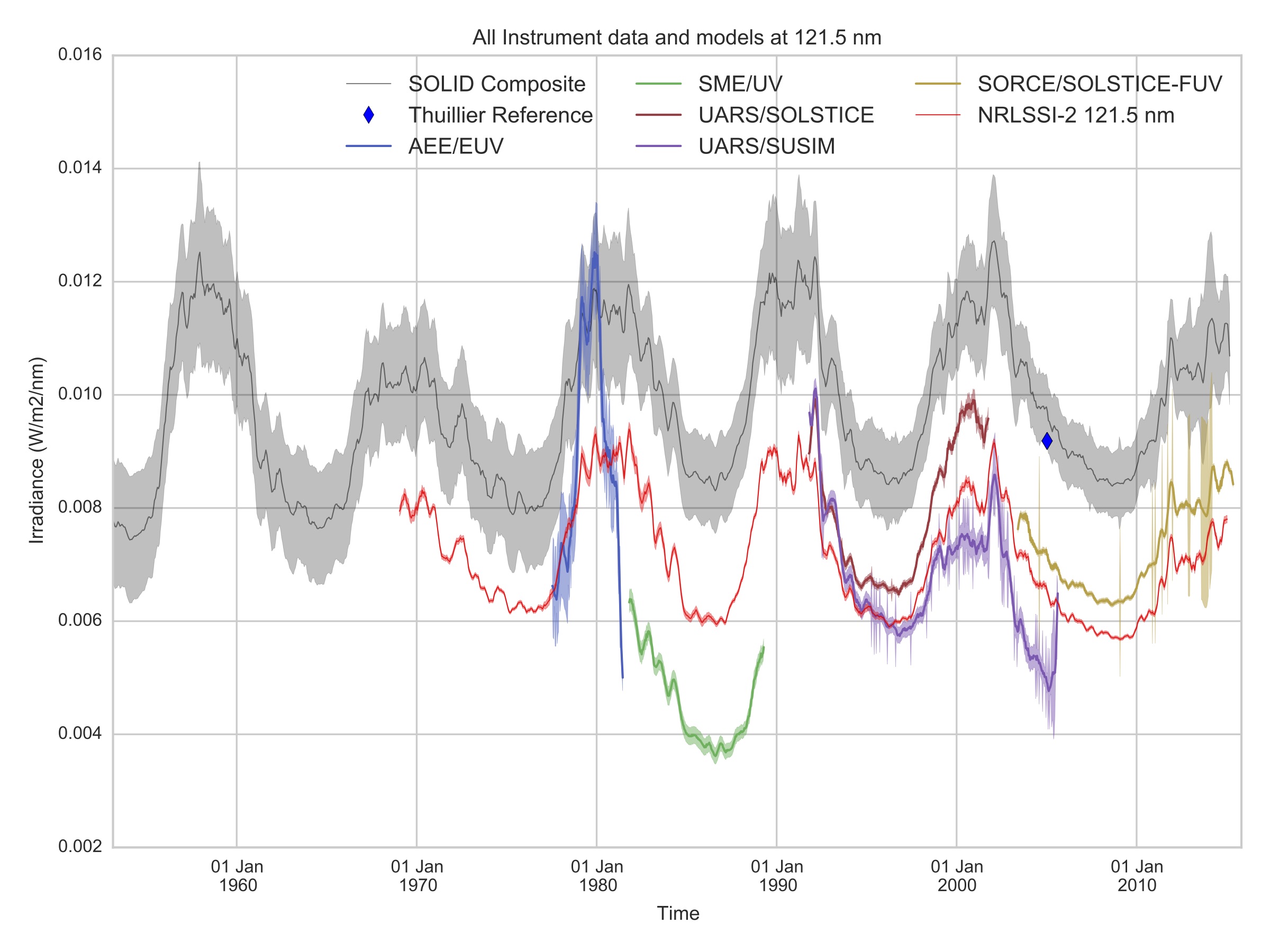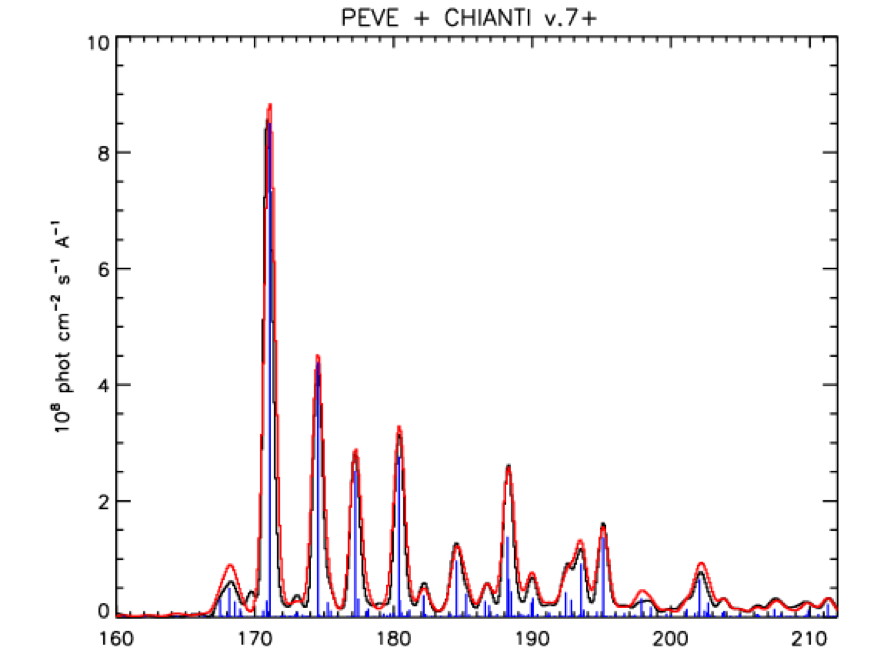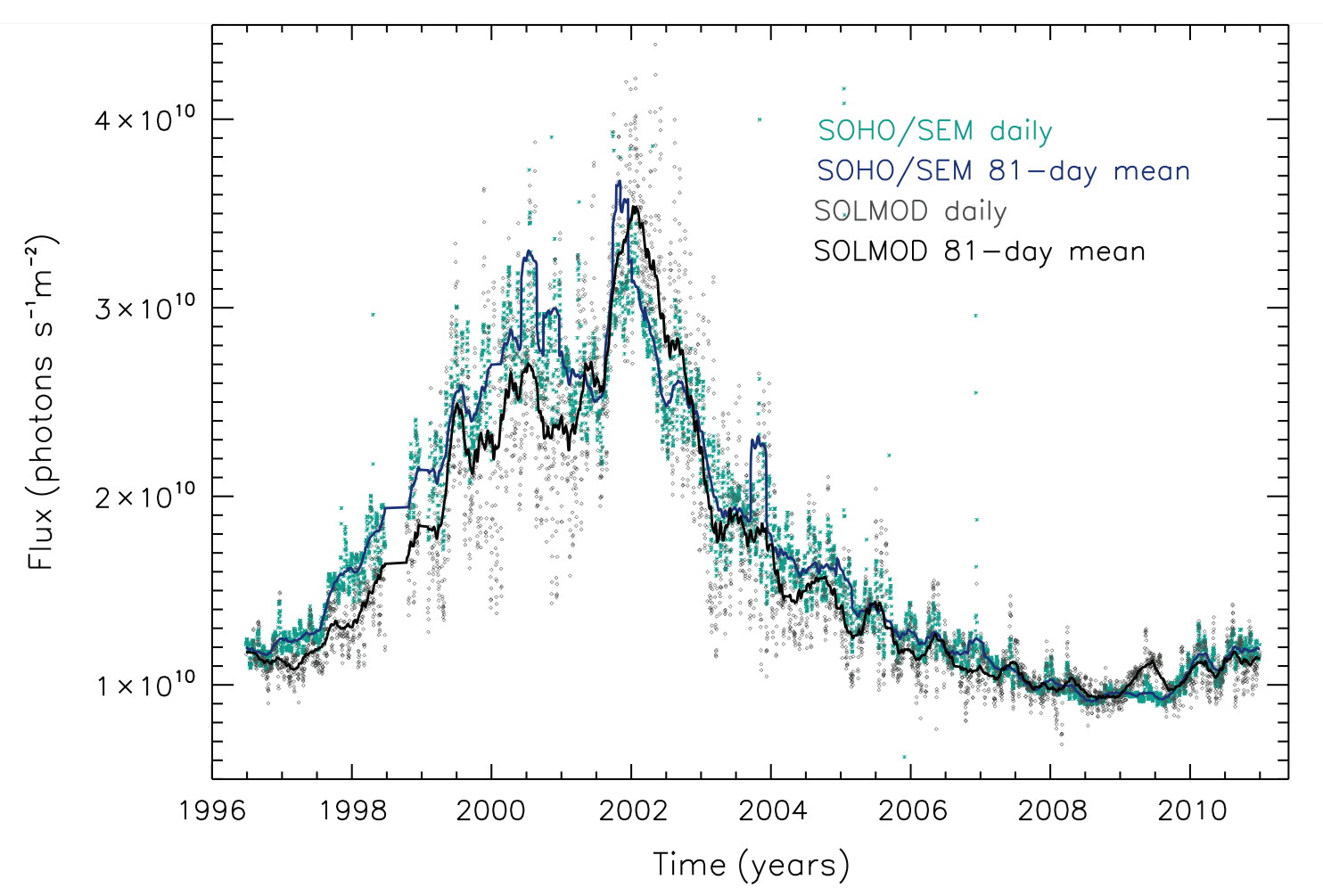WP4 Modelling of spectral irradiance based on observed proxies
This work-package aims at developing and improving models for reconstructing the solar spectral irradiance (SSI) by empirical means only, using direct SSI observations, and solar proxy data. Its main task is to build a single composite dataset out of multiple existing observations. Additional tasks involve the improvement of various empirical models that are used to deliver such proxy data, to perform a statistical analysis of the reconstructed SSI, and to provide a physical interpretation of observed variations. The activity peaked during the last year of SOLID, with the making of the observational SSI composite dataset.
Key tasks and achievements
1) Reconstruct the SSI from direct observations and from solar proxies
2) Comparative Study and improvement of the atomic data used in SOLMOD and CHIANTI
3) Improvement of solar atmosphere models and reconstruction of the SSI spectrum based on filling factors from solar image analysis
1. Reconstruct the SSI from direct observations and from solar proxies
This task, which is at the heart of the SOLID project, involves the empirical reconstruction of the SSI from observations and solar proxies only, with all the technical issues that go with it.
Most of the preprocessing, such as outlier detection and gap filling has been done within work-package 2 (WP2). Here we concentrate on the merging itself, and on the estimation of meaningful confidence intervals. We developed for that purpose a multi-scale maximum likelihood technique that averages the SSI data scale by scale, by taking into account their uncertainties. Periods with no observations are filled in by using solar proxies.
Achievements: Version 1.0 of our observational composite is ready ! This dataset contains daily averages from 1/1/1957 till 31/12/2014, at wavelengths between 10 and 10’000 nm (see http://projects.pmodwrc.ch/solid/index.php/main-database). This dataset is a major achievement, which brings together over 40 datasets in one single composite. In its present version, none of the inputs have been corrected or adjusted. Future versions of this dataset will benefit form comparisons with SSI models to correct some of the observations.
Using the same approach, we built a new composite of the Total Solar Irradiance (TSI), out of which the new official TSI reference is being elaborated in partnership with a team at the International Space Science Institute (ISSI).

Further reading:
- Schöll, M., Dudok de Wit, T., Kretzschmar, M., Haberreiter, M., Making of a solar spectral irradiance data set: data and methods, Journal of Space Weather and Space Climate, in press (2016a).
- Schöll, M., et al., A new solar UV irradiance observational composite, to be submitted (2016b).
- Dudok de Wit, T., G. Kopp, C. Fröhlich, and M. Schöll, Making a composite out of multiple observations: the new Total Solar Irradiance composite, to be submitted (2016).
2. Comparative Study and improvement of the atomic data used in SOLMOD and CHIANTI
Spectral reconstruction models heavily rely on complete atomic data sets for properly estimating emissions in EUV and UV bands. The CHIANTI database has become a reference in the field, though new data and ions are still being added to it. SOLID offered a unique opportunity to perform a comparative study between the EUV/UV spectral radiances/irradiances as observed by various instruments, and as obtained by models that use CHIANTI atomic data.
Achievements: The main outcome is the production of a large set of new atomic data for a range of ions, also including neutrals, and low charge states, which are now included in the new release of CHIANTI v8. The completeness of the atomic data has been checked against higher-resolution datasets, showing significant improvement in the soft X-ray, EUV and UV ranges, as observed by the SOHO CDS, SUMER and Hinode EIS QS instruments. The results from this study have been used within the CHIANTI team in order to improve the atomic database and the subsequent spectral modelling as carried out with the SolMod3D model.

Figure 2: Comparison between the spectral irradiance in the EUV as measured by SDO/EVE (black), and reconstructed with CHIANTI (red). The main emission lines are shown in blue. The abscissa is the wavelength in Angstrom.
Further reading:
- Del Zanna, G., K. P. Dere, P. R. Young, E. Landi, and H. E. Mason, CHIANTI - An atomic database for emission lines. Version 8, Astronomy and Astrophysics, 582 (2015), A56. [link]
3. Improvement of solar atmosphere models and reconstruction of the SSI spectrum based on filling factors from solar image analysis
One of the objectives of SOLID is to model the spectral intensity in the XUV/EUV/UV for different features of the solar corona - here by using the radiative transfer code SolMod3D. Weighting the synthetic spectra of these features with the relative area coverage (as derived by WP3) then allows us to reproduce the variability of the SSI. Here we consider semi-empirical coronal structures, which also allows to account for opacity effects in the solar corona.
Achievements: Major progress has been achieved in the modelling of the Lyman-alpha line, under the assumption of non-local thermodynamic equilibrium (NLTE), by using the COSI code. We successfully reconstructed the SSI by using various types of images taken in the EUV (either SOHO/EIT, PROBA2/SWAP, or PICARD/SODISM), and in the visible (PSPT Ca II). The agreement is excellent in the EUV and UV, whereas amplitude corrections are still needed in the visible.

Figure 3: Comparison of the SOLMOD reconstruction (gray) with the observed SOHO/SEM (light blue) irradiance data. The 81-day mean is also given for the reconstruction (black line) and the SOHO/SEM data (dark blue line) [Haberreiter et al., SWSC 4 (2014) A30].
Further Reading
- Haberreiter, M., V. Delouille, B. Mampaey, C. Verbeeck, G. Del Zanna, and S. Wieman, Reconstruction of the solar EUV irradiance from 1996 to 2010 based on SOHO/EIT images, Journal of Space Weather and Space Climate, 4 (2014), A30. [link]
Deliverables
D4.1) SSI record based on empirical reconstruction from solar proxies [month 12]
D4.2) Improved atmosphere structures for the synthesis of the EUV/UV spectrum [month 6]
D4.3) Improvement of the atomic data set employed in the spectral synthesis [month 12]
D4.4) Reconstruction and validation of EUV/UV Spectral irradiance based on SOHO/EIT, PSPT and Ca II images [month 12]
D4.5) Reconstruction and validation EUV/UV Spectral irradiance based on PROBA2/SWAP, PSPT and Ca II images [month 18]
D4.6) Reconstruction and validation EUV/UV Spectral irradiance based on PICARD/SODISM, PSPT and Ca II images [month 24]
D4.7) Comprehensive SSI data set from the EUV to IR for the Space Era based on all available image analyse [month 30]
D4.8) Recommendation for SSI variations for WP6 [month 34]
References
-
Del Zanna, G., K. P. Dere, P. R. Young, E. Landi, and H. E. Mason, CHIANTI - An atomic database for emission lines. Version 8, Astronomy and Astrophysics, 582 (2015), A56. [link]
-
Haberreiter, M., V. Delouille, B. Mampaey, C. Verbeeck, G. Del Zanna, and S. Wieman, Reconstruction of the solar EUV irradiance from 1996 to 2010 based on SOHO/EIT images, Journal of Space Weather and Space Climate, 4 (2014), A30. [link]
-
Schöll, M., Dudok de Wit, T., Kretzschmar, M., Haberreiter, M., Making of a solar spectral irradiance data set: data and methods, Journal of Space Weather and Space Climate, in press (2016a).
-
Schöll, M., et al., A new solar UV irradiance observational composite, to be submitted (2016b).
-
Dudok de Wit, T., G. Kopp, C. Fröhlich, and M. Schöll, Making a composite out of multiple observations: the new Total Solar Irradiance composite, to be submitted (2016).